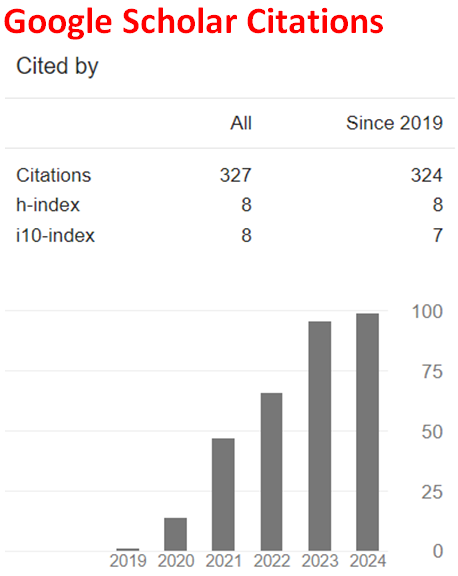Study of the Thermodynamic Quantities of Adsorption and Activation of Piroxicam in Copper Corrosion in a Nitric Acid Environment
Abstract
The objective of this work is to assess the inhibitory efficacy of the piroxicam molecule on copper corrosion in a 1M nitric acid medium using the mass loss technique (gravimetry). The inhibition efficiency, represented as IE (%), increases with higher concentrations and temperatures. Various adsorption isotherm models (Langmuir, El-Awady, Freundlich, and Temkin) were employed to describe the interactions between the molecule and metallic copper. The Dubinin-Radushkevich isotherm, along with the Adejo-Ekwenchi isotherm, was utilized to identify the types of adsorption. Additionally, the thermodynamic adsorption and activation functions were determined and analyzed.
Downloads
References
Oteino-Alergo, V., Huynh, N., Notoya, T., Bottle, S. E., & Schweinsberg, D. P. (1999). Corrosion Science, 41(4), 685.
Ho, C. E., Chen, W. T., & Kao, C. R. (2001). Journal of Electronic Materials, 30(4), 379.
Numez, I., Reguera, E., Corvo, F., Gonzalez, E., & Vasquez, C. (2005). Corrosion Science, 47(2), 461-484.
Christy, A. G., Lowe, A., Otieno-Alego, V., Stoll, M., & Webster, R. D. (2004). Journal of Applied Electrochemistry, 34(2), 225-233. https://doi.org/10.1023/b:jach.0000009923.35223.f8
Landolt, D. (1993). Traité des matériaux: Corrosion et chimie de surfaces des métaux. Coll Ecole Polytechnique de Lausanne: Press Polytechnique et Universitaire Romandes.
Jadhav, S. A. (2011). Self-assembled monolayers (SAMs) of carboxylic acids: an overview. Central European Journal of Chemistry, 9(3), 369-378. https://doi.org/10.2478/s11532-011-0024-8
Ulman, A. (1996). Formation and structure of self-assembled monolayers. Chemical Reviews, 96(4), 1533-1554. https://doi.org/10.1021/cr9502357
Donatien, E. A., Amara, B., Ayemou, D. F., Bamba, A., & Leto, D. (2023). Study of the inhibitory performance of Bisoprolol against copper corrosion in nitric acid. Chemical Science Review and Letters, 12(45), 23-36.
Donatien, E. A., Amara, B., Hadja, T. et al. (2023). Inhibition effect of Tenoxicam on copper corrosion in HNO3: Experimental study and DFT. American Journal of Materials Science and Engineering, 11(1), 7-15. https://doi.org/10.12691/ajmse-11-1-2
Donatien, E., Amara, B., Kalifa, M., Eric, K., Massogbè, D., Ali, S., Rodrigue, K. A., & Marius, N. P. (2023). Meloxicam performances for copper corrosion inhibition in 1M HNO3: Experimental and theoretical approaches. Journal Current Physical Chemistry, 13(1), 20-36. https://doi.org/10.2174/1877946813666221117101443
Donatien, E. A., Kafoumba, B., Roland, K. G., Amara, B., Adjoumani, K., Rodrigue, K., & Diarrassouba, F. (2021). Inhibition effect of Atenolol on copper corrosion in 1M HNO3: Experimental study and DFT. International Research Journal of Pure & Applied Chemistry, 22(8), 1-13. https://doi.org/10.9734/irjpac/2021/v22i830423
Khadom, A. A., Yaro, A. S., & Kadum, A. A. H. (2010). Corrosion inhibition by naphthylamine and phenylenediamine for the corrosion of copper-nickel alloy in hydrochloric acid. Journal of the Taiwan Institute of Chemical Engineers, 41(1), 122-125. https://doi.org/10.1016/j.jtice.2009.08.001
Musa, A. Y., Khadom, A. A., Kadhum, A. A. H., Mohamad, A. B., & Takriff, M. S. (2010). Kinetic behavior of mild steel corrosion inhibition by 4-amino-5-phenyl-4H-1,2,4-trizole-3-thiol. Journal of the Taiwan Institute of Chemical Engineers, 41(1), 126-128. https://doi.org/10.1016/j.jtice.2009.08.002
Rahim, A., & Kassim, J. (2008). Recent development of vegetal tannins in corrosion protection of iron and steel. Recent Patents on Materials Science, 1(3), 223-231. https://doi.org/10.2174/1874464810801030223
Temkin, M. I. (1941). Adsorption equilibrium and process Kinetics on inhomogeneous surfaces with interaction between adsorbed molecules. Zhurnal Fizicheskoi Khimii, 15(3), 296-332.
El Awady, Y. A., & Ahmed, A. I. (1985). Effect of temperature and inhibitors on the corrosion of aluminium in 2N HCl solution, A kinetic study. Journal of Indian Chemistry, 24, 601-606.
Langmuir, I. (1916). The constitution and fundamental properties of solids and liquids. Journal of the American Chemical Society, 38(11), 2221-2295. https://doi.org/10.1021/ja02268a002
Villamil, R. F. V., Corio, P., Agostinho, S. M. L., & Rubim, J. C. (1999). Effect of sodium dodecylsulfate on copper corrosion in sulfuric acid media in the absence and presence of benzotriazole. Journal of Electroanalytical Chemistry, 472, 112-116. https://doi.org/10.1016/s0022-0728(99)00267-3
Bockris, J. O. M., & Reddy, A. K. N. (1977). Modern electrochemistry. New York: Plenum.
Banerjie, G., & Malhotra, S. N. (1992). Corrosion Science, 48(1), 10.
Adejo, S. O., Ekwenchi, M. M., Ahile, J. U., Gbertyo, J. A., & Kaio, A. (2014). Proposing a new empirical adsorption isotherm known as Adejo-Ekwenchi isotherm. Journal of Applied Chemistry, 6(5), 66-71. https://doi.org/10.9790/5736-0656671
Karahan, S., Karahan, S., Ulucan, Z., & Ekincioğlu, Y. (2006). Removal of boron from aqueous solution by clays and modified clays. Journal of Colloid and Interface Science, 293(1), 36-42. https://doi.org/10.1016/j.jcis.2005.06.048
Saliyan, V. R., & Adhikari, A. V. (2008). Corrosion Science, 50(1), 55.
Gomma, G. K. (1998). Mechanism of corrosion behavior of carbon steel in tartaric and malic acid in the presence of Fe2+ ion. Materials Chemistry and Physics, 52, 200-206. https://doi.org/10.1016/s0254-0584(97)02046-4
Lebrini, M., Lagrenée, M., Vezin, H., Traisnel, M., & Bentiss, F. (2007). Experimental and theoretical study for corrosion inhibition of mild steel in normal hydrochloric acid solution by some new macrocyclic polyether compounds. Corrosion Science, 49(5), 2254-2269. https://doi.org/10.1016/j.corsci.2006.10.029

This work is licensed under a Creative Commons Attribution 4.0 International License.


